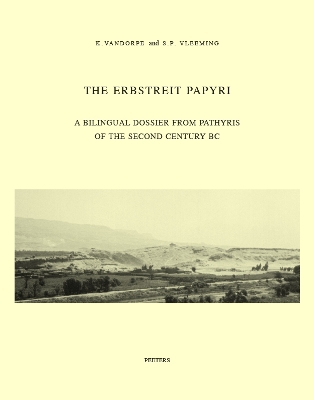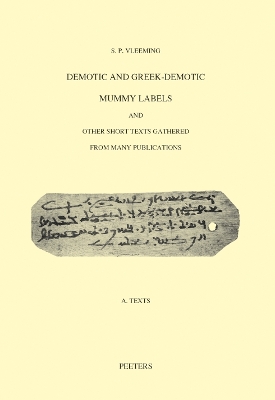Studia Demotica
2 primary works • 4 total works
Volume 12
Demotic Graffiti and Other Short Texts Gathered from Many Publications
by S. P. Vleeming
demotic votive inscriptions (vol. I) and mummy labels (vol. II), this
volume brings together all but 800 demotic and Greek-demotic graffiti.
These are in principle all the graffiti published in periodicals, congress
proceedings and colloquia and Festschrifts, as well as in
monographs that are not exclusively concerned with demotic graffiti
(chiefly excavations reports). The texts are presented in topographical
order from South to North, with those from a single monument kept
together. The texts show the full gamut of themes encountered in demotic
graffiti, which are more varied than their reputation would suggest: the
commemorative inscriptions often have more to offer than just names and
provide information about the careers of the inscribers, occasionally even
touching on historical events of a larger scale. Specifically the numerous
and variegated graffiti from the stone quarries in Middle Egypt and at
Tura and Masara opposite ancient Memphis deserve to be mentioned because
many of these texts are published here for the first time. Several
clusters of these quarry graffiti belong to the first demotic texts that
were recorded in the nineteenth century, and they constitute the only
extant copies for many texts that have now been destroyed.
In
addition, there are some three hundred brief inscriptions on various
objects such as coins, hieratic papyri and mummy linen, stelae, sculptors'
models and plaques, various vases and amphoras, containers for embalming
materials, dishes for the preparation of kyphi, and various other
objects. Although only a few of these may be regarded as proper graffiti,
most of them show a comparable close relationship with the objects on
which they are to be found - for example the notes on stelae, papyri and
mummy bandages, or the marks on wooden coffin boards or drums of stone
columns - which is why we have collected them in this volume, trusting
that the reader will not be misled as to their nature by the title of the
volume.
There are also some sixty further additions to Short
Texts volumes I and II: some stelae, a number of mummy labels and
strips of mummy linen, including two previously unpublished linen pieces
from Lille University.
Volume 13
The Erbstreit papyri, nineteen papyri with twenty texts, now dispersed over five different collections, represent a bilingual dossier that was collected in Antiquity as a result of inheritance disputes. They were once part of a family archive kept in the Upper-Egyptian town of ancient Pathyris, modern Gebelein. The disputes started after the death of the woman Tamenos, daughter of Panas alias Hermokrates, when members from several branches of her family claimed the plots of land she had bequeathed to her children. A series of lawsuits ensued which were dealt with by a wide range of officials, starting with the local Provost Nechoutes up to the Viceroy Boethos, to be settled eventually before the Greek high court from Ptolemais in Middle Egypt when in session in Thebes. The dossier is composed of written evidence produced by the parties, court minutes, court decisions, copies of temple oaths and amicable settlements. One of the attractive features of the dossier are the Greek translations of Egyptian pieces of evidence presented in the Greek courts. The volume provides a substantial introduction outlining the respective stages in the juridical dealings as well as (re-)editions of and comments in detail on the Greek and demotic texts. Appendixes on bilingualism and on Graeco-Egyptian double names as well as indexes and photographic plates complete the volume.
v.3
v.9
Demotic and Greek-demotic Mummy Labels and Other Short Texts Gathered from Many Publications
by S. P. Vleeming
Five Appendices treat of various textual, onomastic and palaeographic problems chiefly concerning the mummy labels, which bring new insights in these domains for the Roman period.


